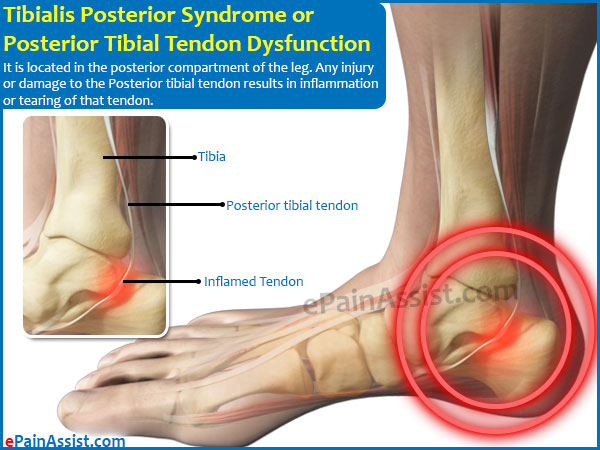Tibialis Posterior Syndrome[¹] is also called as Posterior Tibial Tendon Dysfunction (PTTD).
Causes of Tibialis Posterior Syndrome or Posterior Tibial Tendon Dysfunction
Tibialis posterior muscle is located in the posterior compartment of the leg. Any injury or damage to the Posterior tibial tendon results in inflammation or tearing of that tendon. Due to the dysfunction of the tendon, it is not able to stabilize and support the arch of the foot and results in fallen arch or flatfoot. The Tibialis Posterior muscle helps in plantar flexing of the ankle and inverting the foot. The terms Tibialis Posterior Syndrome and Tibialis Posterior Tendinopathy are often used interchangeably; however, the actual meaning of these conditions is different. Tibialis posterior tendinopathy is injury to the Tibialis Posterior tendon that is degenerative in nature and very painful. Tibialis Posterior Syndrome or Posterior Tibial Tendon Dysfunction is a dysfunction of the muscle causing fallen arches or flat feet. As the function[²] of the Tibialis Posterior muscle is foot inversion, any damage to the muscles results in fallen arches and flat feet. This condition may lead to other conditions such as plantar fasciitis.

Tibialis Posterior Syndrome or Posterior Tibial Tendon Dysfunction is quite common in women.
Symptoms of Tibialis Posterior Syndrome or Posterior Tibial Tendon Dysfunction
- A fallen arch or flatfoot is one of the primary symptoms of Tibialis Posterior Syndrome or Posterior Tibial Tendon Dysfunction.
- Pain at the internal side of the foot and ankle.
- Swelling may be present in Tibialis Posterior Syndrome or Posterior Tibial Tendon Dysfunction.
- Increasing pain with forceful or high-impact activities e.g. running.
- There may be difficulty in walking or standing for people suffering from Tibialis Posterior Syndrome or Posterior Tibial Tendon Dysfunction.
- Pain on the external side of the ankle. When the arch of the foot falls, the heel bone commonly shifts to a new position externally causing pressure on the external part of the ankle bone.
- Previous history of injury to the tibialis posterior muscle.

Treatment[³] of Tibialis Posterior Syndrome or Posterior Tibial Tendon Dysfunction
- Rest is very important in cases of Tibialis Posterior Syndrome or Posterior Tibial Tendon Dysfunction. It is advisable to stay off all activities that worsen the pain. Low-impact exercise like swimming can be helpful.
- Strengthening exercises of the tibialis posterior muscle can be done using rehab band.
- Cold therapy can be applied. Keeping cold pack over the painful area of the posterior tibial tendon for 15 to 20 minutes each time for a minimum of 3 times a day helps reduce the swelling.
- NSAIDs such as ibuprofen and naproxen help in reducing pain and inflammation due to Tibialis Posterior Syndrome or Posterior Tibial Tendon Dysfunction.
- Custom made arch support insoles can be used for support.
- Wearing a Lace-up ankle brace is also quite helpful in treating Tibialis Posterior Syndrome or Posterior Tibial Tendon Dysfunction.
- Sports massage is beneficial for Tibialis Posterior Syndrome or Posterior Tibial Tendon Dysfunction.
- Electrotherapy and exercise rehabilitation are also beneficial.
- Steroid injections can be given around the tendon.
Strengthening Exercises[⁴] for Tibialis Posterior Syndrome or Posterior Tibial Tendon Dysfunction
Resistance Band Exercise for Tibialis Posterior Syndrome or Posterior Tibial Tendon Dysfunction

- The resistance band is wrapped around the mid foot and then stretched out to the side.
- The foot is then inverted and the toes are pointed down at the same time.
- This helps in strengthening the tibialis posterior muscle.
Recovery Period of Tibialis Posterior Syndrome or Posterior Tibial Tendon Dysfunction
Symptoms of pain associated with Tibialis Posterior Syndrome or Posterior Tibial Tendon Dysfunction usually last for more than 12 weeks despite early initiation of treatment and it can even last as long as more than 6 months if the patient has been suffering from pain for a long time without treatment.
